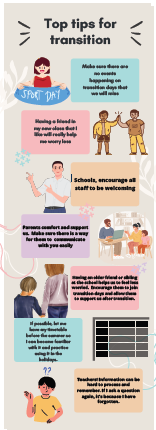Every day they navigate environments and systems that do not readily meet their sensory and social needs. For this reason, it helps when things are predictable. Knowing what to expect in terms of environments and timetables can help autistic people to feel safe and comfortable and make it easier to do everyday tasks. It is not uncommon for autistic people to be insistent on sticking to routines. For example: the order in which they get ready to leave the house in the morning or get ready for bed at night.
It might be very important to do certain things in the same way every time. For example: having a preferred seat and cutlery at mealtimes. Autistic people may carry out repeated actions – such as rocking, pacing, or repeating particular words and phrases (Click here to view an article on stimming).
Any type of repetition and routine help to make things predictable and give a feeling of comfort and safety to autistic people. Changes, disruptions and any kind of unfamiliarity can result in an autistic person feeling uncomfortable, unsafe and stressed.
This can occur when:
- Routines or environments are disrupted or changed
- Events do not happen as expected or in the same familiar way
- The person is expected to meet and/or interact with new, unfamiliar people
- The person is unable to carry out their usual repeated comforting actions
Big life changes– such as starting a new school or college – can be especially difficult, as this typically involves many different changes, unpredictability and unfamiliarity.
The key to adjusting smoothly to these big changes is about recognising the importance of predictability and familiarity. If you are a parent, carer or educator, it will help if you can support the autistic person to gently let go of current routines, environments and people – and gently build up to new ones. Supporting them to learn about what to expect in advance, plus giving them time to adjust to all the new changes, will go a long way to helping them feel more in control, less stressed and more comfortable with their new routine and environment.
If you are an autistic person getting ready to make a big change to a new school or college, there are things you can try to make the change easier and less stressful. It’s all about familiarising yourself with the new environment, routines and people, so that you know what to expect and minimise any unexpected surprises. This will help you feel safe, comfortable and ready to learn. Consider asking for a meeting with a staff member from your new school – and take with you a list of things you want to ask them and things you want to tell them. If for any reason you cannot have a meeting, consider emailing your new school or college with this list. Don’t forget to ask for help from your family or your current teachers if you need to.
Tips to support a positive transition
Note: This video was not produced by Leicestershire Partnership NHS Trust and may contain adverts.
Environment
- If possible, arrange to visit your new school or college. If you are able, ask if you can have more than one visit. Perhaps the first one could be during a quiet time – such as during a school holiday.
- Many schools and colleges have ‘transition days’ designed to help students familiarise themselves with what to expect.
- Ask for permission to photograph key areas
- Ask to be shown form rooms, subject classrooms, assembly halls, library, reception desk and student support.
- Make sure to look around the toilets, eating areas, and social spaces.
- If you are not able to visit in person, request a video meeting where you can ask questions about what to expect.
- Also ask if the school can provide a virtual (video) tour of the school, so new students, their parents and carers can take a “walk” around the key locations.
- Videos showing scenes from a regular school day and shot from the perspective of students can be the most useful.
- Videos can be replayed multiple times. This repetition can help to build predictability and reduce stress.
- Ask for a map of the school. Familiarise yourself with this. Also try to familiarise yourself with specialist areas of the school or college. For example, there might be a ‘science block’ or ‘art block’.
Routine and Timetable
- Find out about the timetable for the new school or college day – including what happens first thing in the morning and at break, lunch and home time. This might be very different from what you are used to.
- Find out which subjects you will be studying that are new to you. For any that you have never heard of before, try to find out a little bit about them, so that you know what sorts of topics the lessons might cover.
- Find out what happens during any specialist lessons, such as a science and PE. These could be in different and unfamiliar environments and require specialist equipment.
- Before you start at your new school or college, practise getting your bag ready for the day – and practise getting things in and out of it.
- Once you have your new timetable, you can display a copy on your wall at home.
- Once you have started your new school or college, get yourself into a routine of checking which lessons you have the next day – so you can make sure you can get your bag packed with the necessary books and equipment.
- You might find it helpful to make a list of what you need for each subject.
- Packing your bag in the evening will save you having to do it in a rush in the morning. It can also help you feel relaxed at bedtime, improving your chances of drifting off into a good night’s sleep.
- Consider making a small sensory bag that you can put inside your school bag which is filled with fidget toys and anything else that helps you.
- For some specialist subjects, like PE and Food Technology, you may need to get organised a few days in advance – to make sure your kit is washed and ready or that you have bought your ingredients in good time. It might help if you set phone reminders or stick up post-it notes for this.
Uniform
- Find out about your new uniform. It may have items that you are not used to such as ties and blazers.
- Once you have bought your new uniform, before you start your new school or college, it might help if you practise putting it on and taking it off – and also spend some time wearing it. This will help you identify any sensory issues and work out anything you can do to help resolve this (such as itchy labels you might need to remove).
- If there are any aspects of the uniform that cannot be changed and that are difficult to tolerate, try to contact the school in plenty of time before the start of term to discuss ideas for reasonable adjustments.
Travel
- You might be travelling to your new school or college in a way that is different from how you have usually travelled to school. You might even be travelling alone or using public transport – which might be unfamiliar to you.
- It may help if you practise the journey multiple times before you start your new school or college. Perhaps do this at first with a trusted adult – and at a quiet time of the day. As you develop your confidence, you can then build up to doing it on your own and at the time of the day that you will usually travel to and from school.
Food
- If you struggle with new foods, find out about the new school or college’s menu. See if there is anything that sounds appealing.
- If not, prepare to take your own packed lunch or snack from home.
Getting familiar with other people
- Before you start your new school or college, ask which person can be your point of contact – for any questions you might have or information you might need to share.
- This might be a mentor, teaching assistant, form tutor, or the SENCo (Special Educational Needs Co-ordinator)
- Your current school should have shared all the important information about you with your new school or college – such as your learning needs and your EHCP (Education Health and Care Plan) if you have one.
- It might also be beneficial for you to share more detail about you, such as what you like, dislike and information about your strengths, interests and difficulties.
- Also share what sorts of things help you – such as when you are struggling with learning, socialising or struggling to manage your emotions.
- You might want to share a ‘One Page Profile’ to help your new school or college staff get to know you (Click here for a template you can use)
- Find out about what’s on offer at break and lunchtimes. There might be clubs and activities you could try where you might get to meet other students who share the same interests.
Preparing for times when things don’t go to plan
- You might find it helpful to think about and / or practise what you might do or say in a range of different situations where you might have to interact with other people – such as in the dinner hall or on the bus.
- Perhaps try out some role-play with a trusted friend or adult.
- This could help you build confidence for dealing with making new friends or dealing with unexpected situations, like what to do if you miss the bus or feel unwell.
Celebrate
Make time to celebrate your achievements and think back on happy memories from primary school. This can help your transition go more smoothly, as it helps you to accept the fact that an ending is happening, and a change is coming.
- Keep a memory box and fill it with photographs and any certificates or awards.
- Compare photos and information from your nursery years with more recent ones.
This can help you realise how much you have grown, matured and learnt – and how much change you have experienced as part of this.
It can give you the confidence to start your new school or college, knowing that you have coped with change before, so you can do it again!
Youth Forum Infographic
The Youth Forum is made up of secondary age young people who all have an autism diagnosis. The ideas were generated by the young people and they were involved at all stages of the creative process. It has been shared with all Leicestershire Schools.




